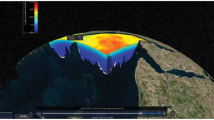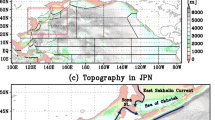Abstract
The Korea Operational Oceanographic System (KOOS) was developed at the Korea Institute of Ocean Science and Technology (KIOST) to produce real-time forecasting and simulation of interdisciplinary multi-scale oceanic fields. This offers valuable information to better mitigate coastal disasters, such as oil spills and other marine accidents, and provides the necessary ocean predictions to support the marine activities of government agencies, marine industries, and public users. The KOOS became operational in March 2012, and consists of several operational modules and realtime observations, including satellite remote sensing, coastal remote monitoring stations using high-frequency radar, and ocean observatories. The basic forecasting system includes weather, regional and high-resolution coastal circulation and wave prediction models; the practical application system includes storm surges, oil spills, and search and rescue prediction models. An integrated maritime port prediction system and data information and skill assessment systems are also part of the KOOS. In this work, the performance of the numerical models was evaluated by the skill assessment systems. From the monthly and yearly skill assessments, the models showed reasonable skill in predicting atmospheric and oceanic states except for the regional ocean circulation models. The ongoing development and improvement of the KOOS includes improvement of the model skills through the upgrade of the satellite-based sea surface temperature algorithm, the enhancement of the ocean monitoring ability, the upgrade of the forecasting models for higher spatial resolutions and the application of data assimilation techniques improved with the feedback from the skill assessment report.
Similar content being viewed by others
References
Breivik Ø, Allen AA (2008) An operational search and rescue model for the Norwegian Sea and the North Sea. J Marine Syst 69:99–113
Cancino L, Neves R (1999) Hydrodynamic and sediment suspension modeling in estuarine systems. Part I: Description of the numerical models. J Marine Syst 22:105–116
Cardone VJ, Cox AT, Greenwood JA, Tompson EF (1994) Upgrade of tropical cyclone surface wind field model. US Army Corps of Engineers, Mics Paper CERC-94-14, 102 p
Cho KH, Choi JY, Jeong SH, Choi JW, Kwon JI, and Park KS (2013) Development of a skill assessment tool for the Korea operational oceanographic system. Acta Oceanol Sin 32(32):74–81
Cho KH, Li Y, Wang H, Park KS, Choi JY, Shin KI, Kwon JI (2014) Development and validation of an operational search and rescue modeling system for the Yellow Sea and the East and South China Seas. J Atmos Ocean Tech 31:197–215
Cornillon P, Gallagher J, Sgouros T (2003) OPeNDAP: Accessing data in a distributed, heterogeneous environment. Data Sci J 2:164–174
Guan L, Kawamura H (2004) Merging satellite infrared and microwave SSTs-Methodology and evaluation of the new SST. J Oceanogr 60:905–912
Hackett B, Breivik Ø, Wettre C (2006) Forecasting the drift of objects and substances in the ocean. In: Chassignet EP, Verron J (eds) Ocean weather forecasting: an integrated view of oceanography. Springer, Dordrecht, The Netherlands, pp 507–523
Hankin S, Callahan J, Sirott J (2001) The Live Access Server and DODS: web visualization and data fusion for distributed holdings. In: 17th Conference on Interactive Information and Processing Systems (IIPS) for Meteorology, Oceanography, and Hydrology. American Meteorological Society, Albuquerque, NM
Holland GJ (1980) An analytic model of the wind and pressure profiles in hurricanes. Mon Weather Rev 108:1212–1218
Hong SY, Noh Y, Dudhia J (2006) A new vertical diffusion package with an explicit treatment of entrainment processes. Mon Weather Rev 134: 2318–2341
Kwon JI, Lee JC, Park KS, Jun KC (2008) Comparison of typhoon wind models based on storm surge heights induced by typhoon Maemi. Asia Pac J Atmos Sci 44:443–454
Lee JC, Kwon JI, Park KS, Jun KC (2008) Calculations of storm surges, Typhoon Maemi. J Korean Soc Coast Ocean Eng 20:93–100
Mateus M, Fernandes R (2008) Modelling pollution: oil spills and faecal contamination. In: Perspectives on integrated coastal zone management in South America. IST Press, Lisbon, pp 89–96
Matsumoto, K, Takanezawa T, Ooe M (2000) Ocean tide models developed by assimilating TOPEX/POSEIDON altimeter data into hydrodynamical model: A global model and a regional model around Japan. J Oceanogr, 56:567–581
Mooers CNK (2010) Quasi-operational coastal ocean nowcast/forecast systems. Terr Atmos Ocean Sci 21:181–193
Oh EK, Yang CS (2011) Study on merging method of SSTs using multi-satellite data. J Korean Soc Mar Environ Safe 17(17):197–202 (in Korean)
Park KS, Lee JC, Jun KC, Kim SI, Kwon JI (2009) Development of an operational storm surge prediction system for the Korean coast. Ocean Polar Res 31(31):369–377
Pinardi N, Woods JD (2002) Ocean Forecasting: conceptual basis and applications. Springer-Verlag, 472 p
Pinardi N, Coppini G (2010) Operational oceanography in the Mediterranean Sea: The second stage of development. Ocean Sci 6:263–267
Schmidt A, Gangopadhyay A (2013) An operational ocean circulation prediction system for the western North Atlantic: hindcasting during July-September of 2006. Cont Shelf Res 63:S177–S192
Skamarock WC, Klemp JB, Dudhia J, Gill DO, Barker DM, Duda MG, Huang X, Wang W (2008) A description of the Advanced Research WRF Version 3. NCAR Technical Note NCAR/TN-475+STR. doi: 10.5065/D68S4MVH
Song Y, Haidvogel DB (1994) A semi-implicit ocean circulation model using a generalized topography-following coordinate system. J Comp Phys 115(115):228–244
Thompson EF, Cardone VJ (1996) Practical modeling of hurricane surface wind field. J Waterw Port C — ASCE 122:195–205
Vickery PJ, Skerlj PF, Steckley AC, Twisdale LA (2000) Hurricane wind field model for use in hurricane simulations. J Struct Eng 126:1203–1221
WAMDI Group (1988) The WAM model — a third generation ocean wave prediction model. J Phys Oceanogr 18:1775–1810
Author information
Authors and Affiliations
Corresponding author
Rights and permissions
About this article
Cite this article
Park, KS., Heo, KY., Jun, K. et al. Development of the Operational Oceanographic System of Korea. Ocean Sci. J. 50, 353–369 (2015). https://doi.org/10.1007/s12601-015-0033-1
Received:
Revised:
Accepted:
Published:
Issue Date:
DOI: https://doi.org/10.1007/s12601-015-0033-1




